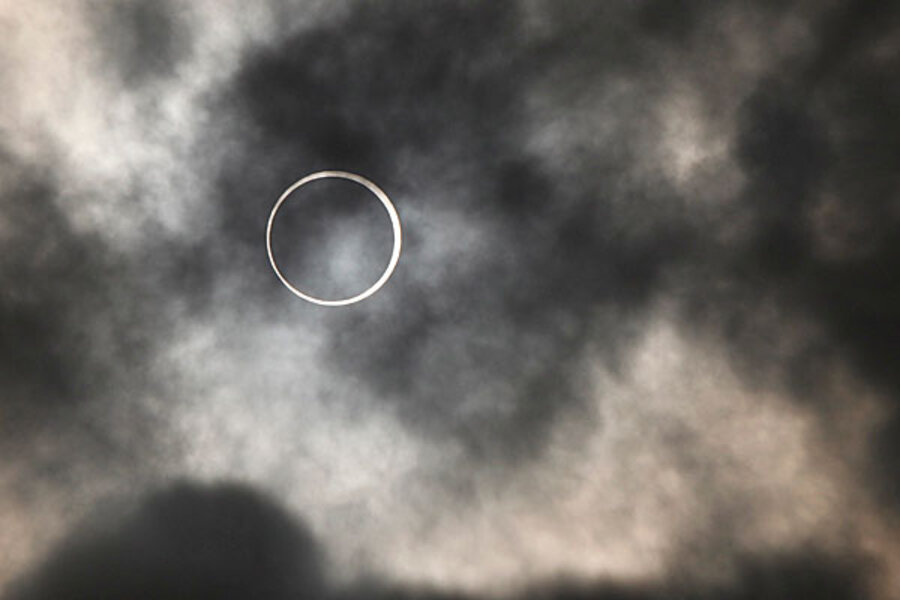'Ring of Fire' eclipse delights millions in Asia, US
Loading...
| Albuquerque, New Mexico
From a park near Albuquerque, to the top of Japan's Mount Fuji, to the California coast the effect was dramatic: The moon nearly blotting out the sun creating a blazing "ring of fire" eclipse.
Millions of people across a narrow strip of eastern Asia and the Western U.S. turned their sights skyward for the annular eclipse, in which the moon passes in front of the sun leaving only a golden ring around its edges.
The rare lunar-solar alignment was visible in Asia early Monday before it moved across the Pacific — and the international dateline — where it was seen in parts of the western United States late Sunday afternoon.
People from Colorado, Oklahoma and as far away as Canada traveled to Albuquerque to enjoy one of the best vantage points at a park on the edge of the city.
Members of the crowd smiled and cheered and children yelled with excitement as the moon crossed the sun and the blazing halo of light began to form. Some watched the eclipse by placing their viewing glasses on the front of their smartphones.
Eventually, the moon centered and covered about 96 percent of the sun.
"That's got to be the prettiest thing I've ever seen," said Brent Veltri of Salida, Colorado.
Elsewhere, viewing parties were held at observatories in Reno, Nevada, and Oakland, California, while skywatchers gathered in coastal and forest counties in California. In some areas, special camera filters for taking photographs have been sold out for weeks in anticipation of the big event.
The eclipse was broadcast live on TV in Tokyo, where such an eclipse hasn't been visible since 1839. Japanese TV crews watched from the top of Mount Fuji and even staked out a zoo south of Tokyo to capture the reaction of the chimpanzees — who didn't seem to notice.
Eclipse tours were arranged in Japan at schools and parks, on pleasure boats and even private airplanes. Similar events were held in China and Taiwan as well, with skywatchers warned to protect their eyes.
A light rain fell on Tokyo as the eclipse began, but the clouds thinned as it reached its peak, providing near perfect conditions.
"It was a very mysterious sight," said Kaori Sasaki, who joined a crowd in downtown Tokyo to watch event. "I've never seen anything like it."
A Japanese zoo said the eclipse apparently made ring-tailed lemurs believe it was evening.
Some 20 lemurs at the Japan Monkey Center in central Japan skipped breakfast, climbed up and jumped between trees and poles, a typical evening behavior, according to the zoo web site. They returned to normal after the eclipse.
"They must be reacting to the eclipse," zoo director Akira Kato told public broadcaster NHK.
At the Taipei Astronomical Museum in Taiwan, the spectacle emerged from dark clouds for only about 30 seconds. But the view was nearly perfect against Manila's orange skies.
"It's amazing. We do this for the awe (and) it has not disappointed. I am awed, literally floored," said astronomical hobbyist Garry Andreassen, whose long camera lenses were lined up with those of about 10 other gazers in a downtown Manila park.
Hong Kong skywatchers weren't so lucky.
Several hundred people gathered along the Kowloon waterfront on Hong Kong's famed Victoria Harbor, most of them students or commuters on their way to work. The eclipse was already under way as the sun began to rise, but heavy clouds obstructed the view.
The eclipse followed a narrow 8,500-mile (14,000-kilometer) path for 3 1/2 hours. The ring phenomenon lasted about five minutes, depending on location. People outside the narrow band for prime viewing saw a partial eclipse.
"Ring of Fire" eclipses are not as dramatic as a total eclipse, when the disc of the sun is entirely blocked by the moon. The moon is too far from Earth and appears too small in the sky to blot out the sun completely.
Doctors and education officials have warned of eye injuries from improper viewing. Before the event started, Japan's Education Minister Hirofumi Hirano demonstrated how to use eclipse glasses in a televised news conference.
Police also cautioned against traffic accidents — warning drivers to keep their eyes on the road.
___
Tallmadge reported from Tokyo. Associated Press writers Mari Yamaguchi in Tokyo, Wally Santana in Taipei, Hrvoje Hranjski in Manila, Kelvin Chan in Hong Kong and photojournalist Julie Jacobson in Kayenta, Arizona, contributed to this report.







